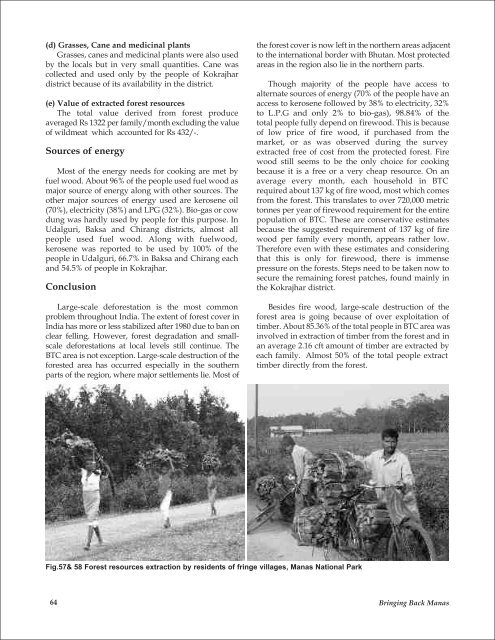Bringing Back Manas
Bringing Back Manas
Bringing Back Manas
- TAGS
- bringing
- manas
- www.ifaw.org
You also want an ePaper? Increase the reach of your titles
YUMPU automatically turns print PDFs into web optimized ePapers that Google loves.
(d) Grasses, Cane and medicinal plants<br />
Grasses, canes and medicinal plants were also used<br />
by the locals but in very small quantities. Cane was<br />
collected and used only by the people of Kokrajhar<br />
district because of its availability in the district.<br />
(e) Value of extracted forest resources<br />
The total value derived from forest produce<br />
averaged Rs 1322 per family/month excluding the value<br />
of wildmeat which accounted for Rs 432/-.<br />
Sources of energy<br />
Most of the energy needs for cooking are met by<br />
fuel wood. About 96% of the people used fuel wood as<br />
major source of energy along with other sources. The<br />
other major sources of energy used are kerosene oil<br />
(70%), electricity (38%) and LPG (32%). Bio-gas or cow<br />
dung was hardly used by people for this purpose. In<br />
Udalguri, Baksa and Chirang districts, almost all<br />
people used fuel wood. Along with fuelwood,<br />
kerosene was reported to be used by 100% of the<br />
people in Udalguri, 66.7% in Baksa and Chirang each<br />
and 54.5% of people in Kokrajhar.<br />
Conclusion<br />
Large-scale deforestation is the most common<br />
problem throughout India. The extent of forest cover in<br />
India has more or less stabilized after 1980 due to ban on<br />
clear felling. However, forest degradation and smallscale<br />
deforestations at local levels still continue. The<br />
BTC area is not exception. Large-scale destruction of the<br />
forested area has occurred especially in the southern<br />
parts of the region, where major settlements lie. Most of<br />
the forest cover is now left in the northern areas adjacent<br />
to the international border with Bhutan. Most protected<br />
areas in the region also lie in the northern parts.<br />
Though majority of the people have access to<br />
alternate sources of energy (70% of the people have an<br />
access to kerosene followed by 38% to electricity, 32%<br />
to L.P.G and only 2% to bio-gas), 98.84% of the<br />
total people fully depend on firewood. This is because<br />
of low price of fire wood, if purchased from the<br />
market, or as was observed during the survey<br />
extracted free of cost from the protected forest. Fire<br />
wood still seems to be the only choice for cooking<br />
because it is a free or a very cheap resource. On an<br />
average every month, each household in BTC<br />
required about 137 kg of fire wood, most which comes<br />
from the forest. This translates to over 720,000 metric<br />
tonnes per year of firewood requirement for the entire<br />
population of BTC. These are conservative estimates<br />
because the suggested requirement of 137 kg of fire<br />
wood per family every month, appears rather low.<br />
Therefore even with these estimates and considering<br />
that this is only for firewood, there is immense<br />
pressure on the forests. Steps need to be taken now to<br />
secure the remaining forest patches, found mainly in<br />
the Kokrajhar district.<br />
Besides fire wood, large-scale destruction of the<br />
forest area is going because of over exploitation of<br />
timber. About 85.36% of the total people in BTC area was<br />
involved in extraction of timber from the forest and in<br />
an average 2.16 cft amount of timber are extracted by<br />
each family. Almost 50% of the total people extract<br />
timber directly from the forest.<br />
Fig.57& 58 Forest resources extraction by residents of fringe villages, <strong>Manas</strong> National Park<br />
64 <strong>Bringing</strong> <strong>Back</strong> <strong>Manas</strong>

















